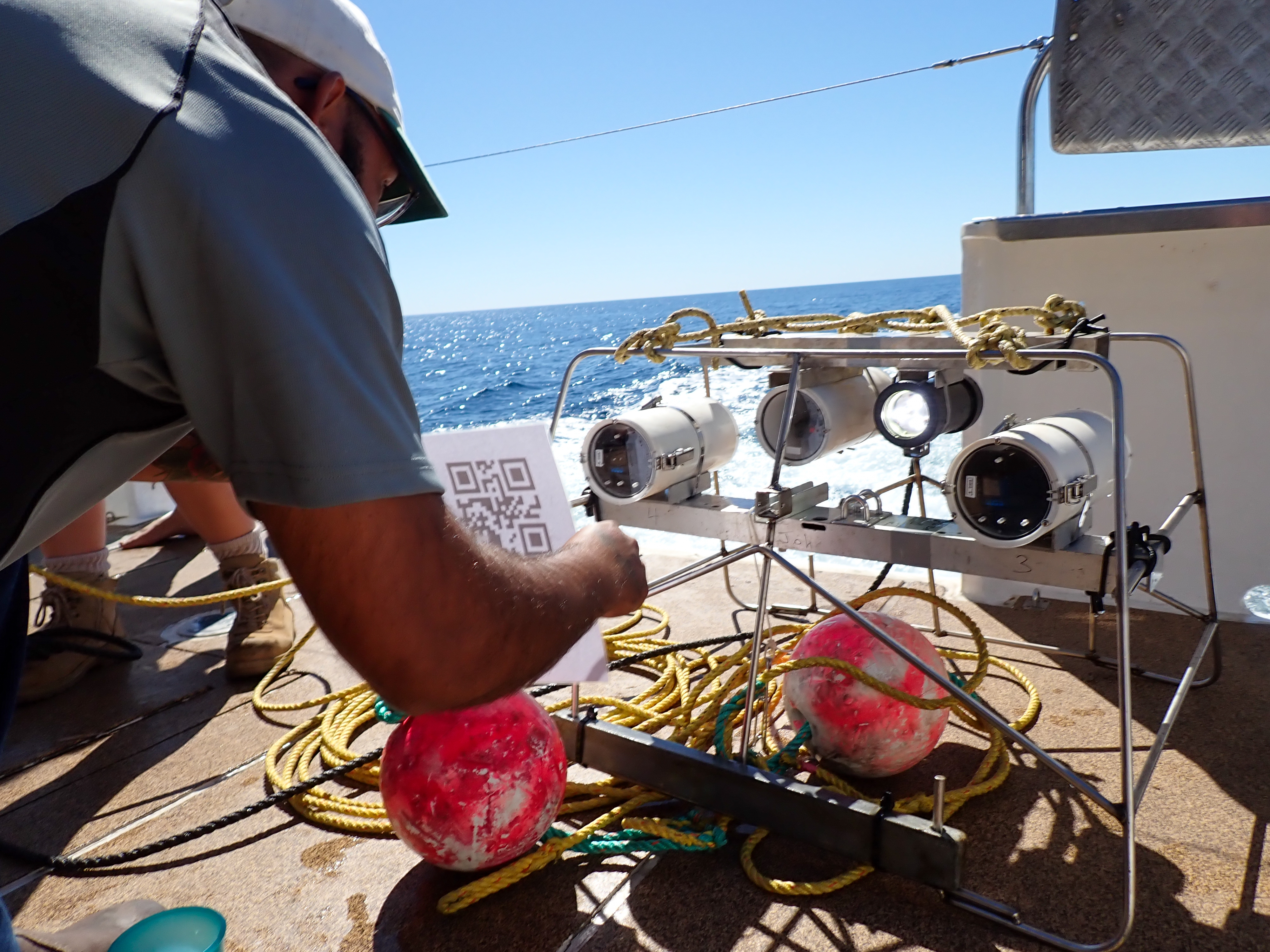Stereo-BRUV systems consist of two convergent video cameras inside waterproof housings, attached to a base-bar (Figure 1b), held in a frame (Figure 1a), with some form of baited container in front of the cameras (Figure 1e). Systems are generally tethered by rope to surface buoys (Figure 1c). Ballast can be added to frames for use in deep-water or areas of strong current (Figure1f).

Figure 1: Equipment required for stereo-BRUV surveys, using Standard design frames (left) and light-weight frames (right) including (a) mild-steel galvanised frame and bridle, (b) stereo base-bar and camera housings, (c) rope with detachable float line and two floats, (d) storage container for equipment and bait, (e) PVC bait arm (reinforced with fibreglass rod) with mesh bait bag and supporting metal diode arm, (f) metal weights for deep-water or strong current, (g) long-armed glove for handling bait, (h) dry kit including calibrated cameras fixed to face plates, spare cameras, spare batteries, battery charger, micro-sd card reader, micro-sd cards, standard tools, cable ties to secure bait bags, and silicone grease for o-ring, (i) base-bar for LED lights and backwards facing camera, (j) LED light, (k) calibrated cameras fixed to face plates, (l) spare battery packs and SD cards, (m) bungee cords to attach base bar to frame, and (n) rope handling gloves.
Cameras and Photogrammetry
We recommend cameras with full, high-definition resolution of at least 1920 x 1080 pixels (Harvey et al. 2010) and a capture rate of at least 30 frames per second (note some models of action cameras can overheat at high resolution e.g. 4K). Higher camera resolution will improve identification of fish, and the pixel selection required for measurement. Higher frame rates reduce blur on fast-moving species. To maintain stereo-calibrations, cameras must have video stabilisation disabled, and a fixed focal length can facilitate measurements both close to and far from the camera systems when correctly calibrated (Shortis, Harvey & Abdo 2009; Boutros, Shortis & Harvey 2015). The field of view should be standardised and chosen to limit distortion in the image (e.g. no more than a medium angle, ~95° H-FOV). When sampling demersal fish assemblages at typical maximum range (8 m) from the cameras, Boutros et al. (2015) suggested a separation < 500 mm will result in a decrease in the accuracy of measurements, with measurement precision being a function of 1/(camera separation). Cameras are fixed to a rigid base bar to preserve the stereo-calibration required to calculate accurate length and range measurements (Harvey & Shortis 1995, 1998; Shortis & Harvey 1998; Shortis et al. 2009; Boutros et al. 2015). The system pictured in the left-hand side of Figure 1 uses GoPro Hero 5 Black cameras, with camera housings separated by 700 mm with 7° convergence angle on a steel base bar, although 500 mm with a 5° convergence angle is also common.
Stereo-calibrations must be made both prior to and following a field campaign. Given the required tolerances involved with stereo-BRUV construction, we recommend seeking manufacture and calibration advice from recognised providers or adhering to strict specifications. Any changes in camera positioning (e.g. if a camera is dismounted during battery replacement) will disrupt the stereo-calibration, resulting in measurement error. For this reason, most “off-the-shelf” housings remain unsuitable for stereo-BRUVs. Figure 1h provides an example of a camera that is secured to the housing faceplate to ensure stability. Each housing and camera should be uniquely identified, ensuring the latter are only used on the system they are calibrated for. A flashing LED may be added to the end of the diode arm to aid synchronisation of imagery from the left and right cameras when submerged (Figure 1).
Newer versions of GoPro cameras (9/10/11/12), paired with GoPro Labs, allow users to quickly set custom settings using QR codes for streamlined configuration of settings.
- Download GoPro Labs firmware file and install it on the camera (gopro.github.io/labs/)
- Generate the QR code either with a web configurator or in GoPro Labs mobile app.
- Point GoPro at the QR code and let the camera scan it automatically.
See here for a step by step guide on setting up a GoPro 12 with QR codes.

Bait
As a general rule, locally sourced, sardine-type oily bait is recommended (Dorman et al. 2012), as the oil disperses to attract fish. Sourcing sardine bait locally from factory discards (e.g. fish heads, tails and guts) will reduce the survey’s ecological footprint, cost of sampling and potential for disease translocation. We recommend 0.8 - 1 kg of roughly crushed bait, positioned between 1.2 m and 1.5 m in front of the cameras with the mesh bait bag as close to the benthos as possible. Positioning outside of this range will reduce the ability to identify and measure individuals.
Deployment Time
Benthic stereo-BRUVs should be deployed for a standard duration. We recommend deployments of 60 min, to allow species detection (Currey-Randall et al. 2020), and facilitate comparison with historical data. Deployments of 30 minutes have been demonstrated to be sufficient for sampling particular species of finfish on shallow temperate reefs (Bernard & Götz 2012; Harasti et al. 2015).

